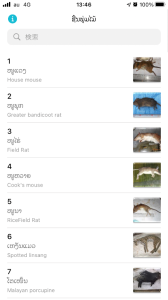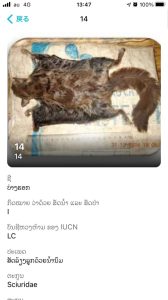The forest-rich Lao PDR is home for many kinds of wild animals.
Even at present some wild animals are used as food.
Bush meat is an important protein source for residents who live in rural areas.
In the Lao PDR, “Wild Animal and Aquatic Law (WAL)” are put in place for wild animal conservation, and in the laws they are classified into three categories based on their conservation levels. And from the international viewpoint, International Union for Conservation of Nature and Natural Resources (IUCN) makes the IUCN Red List, and Washington Convention or CITES (Convention on International Trade of Endangered Species of Wild Fauna) has listed endangered wild animals.
Some local residents do not know that there is WAL for wildlife protection or they do not understand the contents correctly.
One of the reasons is that books in which wild animals are illustrated and materials on wild animal conservation are not common in the Lao PDR.
Eating of wild animals poses risks of parasitic zoonoses like COVID-19 and SARS. From the perspective of public health, it is also important to deepen local residents’ understanding of wild animals.
The newly developed Bush meat database is a free app and can be used in rural areas by using smartphones. We hope that the database we developed will be widely used in such facilities as agricultural offices and health facilities in the prefectures and districts in Laos. Access this database app from NAFRI Web site.
“This database is the result of JIRCAS and FRC joint research.”
Fig. Example of App of “Lao Bushmeat”.
Scan the QR code and register the app in your smartphone. You can see the name and photo of the wild animals and their conservation levels in the Lao wild animal and aquatic laws, the IUCN Red List and CITES (Washington Convention).
Singkone Xayalath, Katsumi Hasada, Kenichiro Kimura








 Users Today : 595
Users Today : 595 Users Yesterday : 1224
Users Yesterday : 1224 This Month : 40960
This Month : 40960 This Year : 137733
This Year : 137733 Total Users : 137733
Total Users : 137733